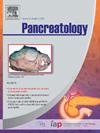Repeated pancreatic juice cytology via endoscopic nasopancreatic drainage catheter combined with clinical findings improves diagnostic ability for malignant cases of suspected pancreatic cancer with non-identifiable tumors
IF 2.8
2区 医学
Q2 GASTROENTEROLOGY & HEPATOLOGY
引用次数: 0
Abstract
Background/objectives
The detection of pancreatic cancer (PC) often depends on indirect indicators such as parenchyma atrophy (PPA), main pancreatic duct stenosis, and low echoic areas, particularly when no mass is evident on imaging. While pathological evaluation is the gold standard for differentiating malignant from benign conditions, endoscopic ultrasound-guided fine-needle aspiration/biopsy is not always feasible in such cases. Serial pancreatic juice aspiration cytologic examination (SPACE) via endoscopic nasopancreatic drainage (NPD) has emerged as an alternative diagnostic method, though its accuracy remains underevaluated. This study aimed to evaluate the diagnostic performance of SPACE and explore strategies to enhance its accuracy in diagnosing PC.
Methods
This multicenter, retrospective study analyzed patients who underwent SPACE between January 2015 and September 2023. The inclusion criteria focused on cases lacking a clear pancreatic mass but exhibiting indirect signs suggestive of PC. Diagnostic accuracy was determined using surgical pathology or a minimum follow-up period of 12 months as the reference standard.
Results
Among 164 patients, 85 (51.8 %) were diagnosed with malignancy. The sensitivity and specificity of SPACE were 74.1 % and 87.3 %, respectively, with a area under the receiver operating characteristic curve (ROC-AUC) of 0.807 (95%CI: 0.748–0.867). Incorporating patient age, CEA and PPA with SPACE results further improved diagnostic performance, yielding a ROC-AUC of 0.828 (95%CI: 0.76–0.897, p = 0.013).
Conclusions
Combining SPACE with clinical and imaging findings significantly enhances diagnostic accuracy in suspected PC cases where conventional imaging fails to detect tumors. This integrated approach has the potential to enhance clinical outcomes by facilitating more accurate patient management.
内镜下鼻胰引流管反复行胰液细胞学检查,结合临床表现,可提高对可疑肿瘤不明的恶性胰腺癌的诊断能力。
背景/目的:胰腺癌(PC)的检测通常依赖于间接指标,如实质萎缩(PPA)、主胰管狭窄和低回声区域,特别是当影像学上没有明显肿块时。虽然病理评估是鉴别恶性和良性的金标准,但在这种情况下,内镜超声引导下的细针穿刺/活检并不总是可行的。经内镜下鼻胰引流(NPD)的连续胰液穿刺细胞学检查(SPACE)已成为一种替代的诊断方法,尽管其准确性仍被低估。本研究旨在评估SPACE对PC的诊断效能,并探讨提高其诊断准确度的策略。方法:这项多中心回顾性研究分析了2015年1月至2023年9月期间接受SPACE治疗的患者。纳入标准集中在没有明确胰腺肿块但表现出提示PC的间接征象的病例。诊断的准确性以手术病理或至少12个月的随访时间作为参考标准。结果:164例患者中85例(51.8%)确诊为恶性肿瘤。SPACE的敏感性和特异性分别为74.1%和87.3%,受试者工作特征曲线下面积(ROC-AUC)为0.807 (95%CI: 0.748 ~ 0.867)。结合患者年龄、CEA和PPA与SPACE结果进一步提高了诊断效能,ROC-AUC为0.828 (95%CI: 0.76-0.897, p = 0.013)。结论:SPACE结合临床及影像学表现可显著提高常规影像学未发现肿瘤的疑似PC病例的诊断准确性。这种综合方法有可能通过促进更准确的患者管理来提高临床结果。
本文章由计算机程序翻译,如有差异,请以英文原文为准。
求助全文
约1分钟内获得全文
求助全文
来源期刊

Pancreatology
医学-胃肠肝病学
CiteScore
7.20
自引率
5.60%
发文量
194
审稿时长
44 days
期刊介绍:
Pancreatology is the official journal of the International Association of Pancreatology (IAP), the European Pancreatic Club (EPC) and several national societies and study groups around the world. Dedicated to the understanding and treatment of exocrine as well as endocrine pancreatic disease, this multidisciplinary periodical publishes original basic, translational and clinical pancreatic research from a range of fields including gastroenterology, oncology, surgery, pharmacology, cellular and molecular biology as well as endocrinology, immunology and epidemiology. Readers can expect to gain new insights into pancreatic physiology and into the pathogenesis, diagnosis, therapeutic approaches and prognosis of pancreatic diseases. The journal features original articles, case reports, consensus guidelines and topical, cutting edge reviews, thus representing a source of valuable, novel information for clinical and basic researchers alike.
 求助内容:
求助内容: 应助结果提醒方式:
应助结果提醒方式:


